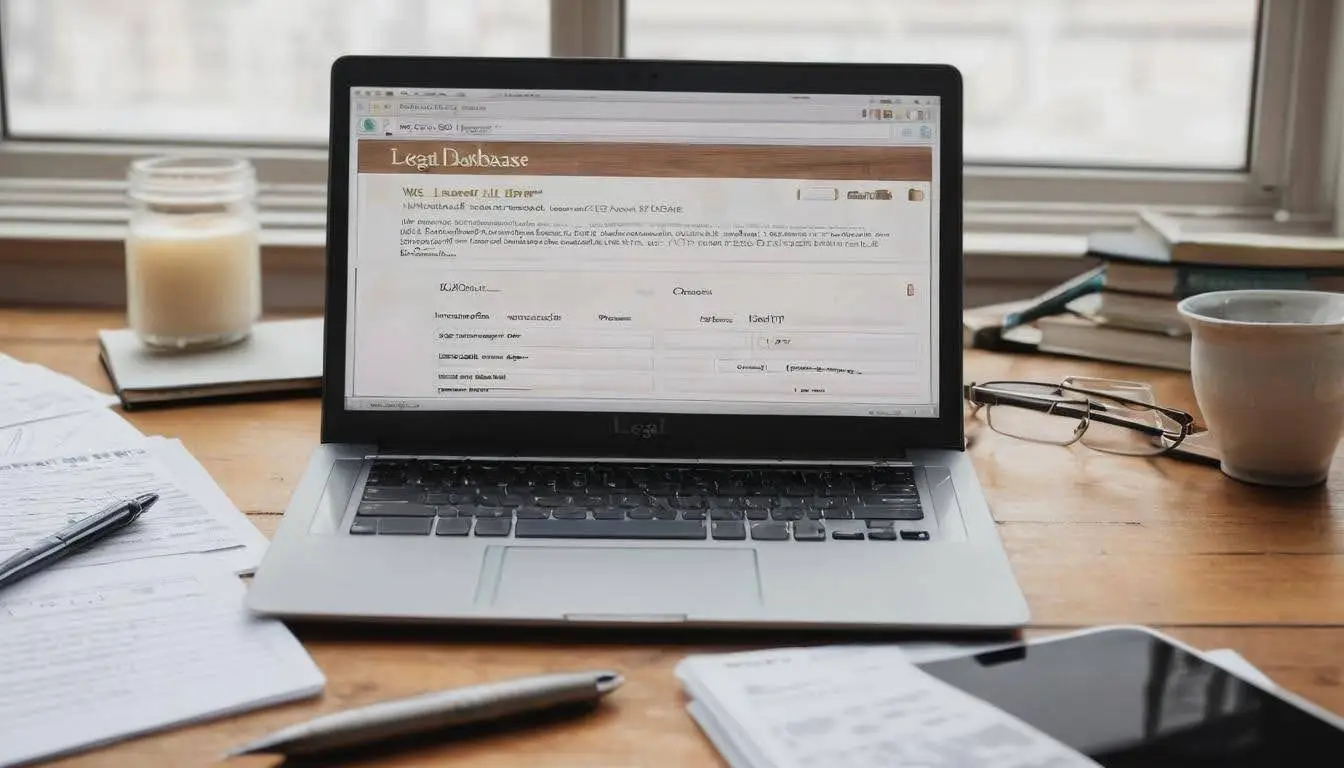

In the whirlwind world of legal practice, having dependable legal sources at your fingertips isn't just helpful—it's indispensable. The very foundation of a solid case rests on accurate, up-to-date information. To stay ahead, one must be adept at navigating through a sea of legal materials, discerning which are trustworthy and which are not.
While pinpointing reliable resources is crucial, it’s equally important to evaluate their credibility continuously. We’ve invested considerable effort into curating a guide that simplifies this complex task. After scrutinizing countless databases and consulting top-tier professionals, we bring you proven strategies to streamline your research process and maintain the integrity of your findings. Let's begin by understanding the first step: identifying reliable legal sources.
To effectively evaluate legal resources, you should utilize the CAST method, which involves examining the Credibility, Accuracy, Scope, and Time of the sources. Ensure that authorship is clear and reputable, verify the accuracy of information through citations, assess whether the resource comprehensively covers the topic without biases, and check for up-to-date content relevant to your research needs.

When engaging in legal research, distinguishing between reliable and unreliable sources is paramount. Think of it like building a house: without a strong foundation, no matter how beautiful the décor, it won’t stand the test of time. Reliable sources ensure that your research is robust and lend credibility to your arguments.
Primary sources are at the top of the hierarchy when it comes to authority in legal matters. These include statutes enacted by legislatures, case law established through judicial decisions, and regulations promulgated by governmental agencies. For instance, relying on the United States Code (USC) or landmark Supreme Court cases solidifies the legal grounding of any argument or opinion presented.
On the other hand, secondary sources play a critical supporting role; these include law review articles, legal encyclopedias, and commentaries that help explain, analyze, or critique primary legal materials. While secondary sources provide valuable context and insight, they lack determinate legal force.
Transitioning from understanding types of sources to identifying their reliability requires an attentive eye. Not all sources are created equally, and navigating through this sea can be challenging.
A fundamental rule for evaluating reliability is to prioritize resources from official government sites. These usually include respected platforms like the Legal Information Institute (LII) at Cornell Law School or bi-partisan databases like Congress.gov, both of which offer accurate updates on legislation and related matters. Resources originating from recognized academic institutions also carry significant weight; journals published by prestigious law schools often feature rigorous peer-reviewed content that adds layers of trustworthiness to your research.
Moreover, reputable articles from established law firms may also serve as reliable secondary sources. These firms typically employ experienced attorneys who contribute their insights based on real-world application and interpretation of the law. As such, references drawn from these articles can greatly enrich your own understanding while ensuring accuracy in your work.
Accessing reliable legal resources is essential to building sound legal arguments. By recognizing primary versus secondary sources and adhering to the markers of credibility outlined here, you’ll set yourself on a path toward successful legal research.
While source identification is foundational, determining the specific criteria for establishing credibility will further enhance your research efforts.

Evaluating the credibility of legal resources is about ensuring you have trustworthy and accurate information in your arsenal. The first thing to consider is Author's Authority. It's essential to identify not only who the author is but also their qualifications, educational background, and professional experience. For instance, an article written by legal scholars like Erwin Chemerinsky or a sitting Supreme Court justice carries a weight of authority that cannot be overlooked. Their expertise and understanding of law add immense value to the content, making it more credible.
Once you've established who authored the material, it’s equally important to investigate where this information is published.
The next criterion is the Publisher's Reputation. Trustworthy publications typically come from reputable legal publishers such as Westlaw, LexisNexis, or Oxford University Press. When these names are attached to an article or book, you can usually rest assured that there has been a rigorous vetting process involved in its creation. These publishers carry a reputation built over time for providing reliable information, enhancing the integrity of your research.
However, identifying reputable sources isn't enough; you must also consider how current the information is.
This brings us to the Currency of Information. In the world of law, changes happen at breakneck speed—new statutes may replace old ones, court decisions can set new precedents, and legal interpretations evolve. Thus, ensuring that any resource you use is up-to-date is crucial. Researching outdated laws might lead you down a path filled with inaccuracies that could undermine your findings. Always check publication dates and confirm if significant revisions have occurred in recent times.
Finally, there’s no better way to gauge the credibility of an article than by examining how it has been reviewed by peers in the field.
Consider Peer Review and Citations as essential components of ensuring reliability. Articles published in peer-reviewed journals have undergone extensive scrutiny by experts before reaching the public eye. This process enriches credibility tremendously. Additionally, articles featuring ample citations from other legitimate sources signal thorough research and bolster trustworthiness. If these citations reference established case law or legislation, it further validates the claims made within.
By evaluating these criteria—author's authority, publisher's reputation, currency of information, and peer review—you forge a solid foundation for determining the reliability of your legal resources.
As we explore these critical evaluation techniques further, understanding how to apply citations can solidify your research approach and enhance its credibility.

Proper use of citations is crucial in any form of legal writing. They serve not just as a nod to the original sources but as essential navigational tools that empower readers to trace back to the roots of your arguments. When done correctly, citations enhance the credibility of your work and strengthen your argument by providing a solid foundation—a clear path back to the original material for verification purposes.
There’s something profoundly important about ensuring that each citation you include acts as a beacon. Accurate citations allow you to locate the original source material, verify the information, and understand the intricate context surrounding it. This step is especially crucial in law, where nuances can define cases, statutes, or legal principles. Without precise references, readers may struggle to trust your assertions or might misinterpret the data being presented.
Alongside accuracy, understanding format can be just as critical for maintaining clarity in your legal documents.
Familiarization with key formats like Bluebook or the ALWD Citation Manual is essential for producing high-quality legal documentation. Each format has specific rules for citing cases, statutes, books, and articles. Therefore, it’s critical to study these particular guidelines. For instance, Bluebook emphasizes uniformity and precision, while ALWD offers slightly different mechanics that still adhere to overall clarity standards. Knowing how to cite properly ensures that anyone reading your work can effortlessly track down the original sources without confusion.
Once you're acquainted with accurate citations and formats, it's time to implement best practices that streamline this process.
An exemplary citation should inherently guide others toward exactly what you referenced. For example: “Brown v. Board of Education, 347 U.S. 483 (1954)” serves as an excellent illustration. It allows readers to pinpoint the exact case swiftly and confirm both accuracy and contextual relevance by providing sufficient details surrounding publication and legal standing.
Embedding these citational techniques into your research habits will not only uphold integrity but also enrich your overall analysis and comprehension within legal discussions as we now explore various methods for assessing research quality.

When evaluating the quality of legal research, you must engage in a thoughtful process that goes well beyond merely locating sources or reading headlines. Instead, focus on a thorough analysis that illuminates the true depth of the topic at hand. This means not just skimming the surface, but rather diving deeply into the intricate layers of the subject matter. High-quality legal research emerges from a commitment to comprehensive exploration, so be sure to examine every facet of your topic.
A crucial element in achieving quality is recognizing that your research should provide nuanced insights into complex issues. Think of your research as a conversation with the law itself; each question you pose should uncover another layer of understanding. By examining numerous dimensions such as historical context, statutory interpretation, and relevant case law, you’ll position your work to resist superficial assessments. This approach will not only enrich your findings but also arm you with the knowledge necessary to anticipate counterarguments in future discussions or analyses.
Moving from depth to methodology, it's essential to consider how you gather and analyze data for your research.
Methodological rigor is another hallmark of high-quality legal research. Engaging in effective research often involves employing qualitative methods like detailed case studies or quantitative approaches such as statistical analysis. For instance, analyzing recent outcomes from multiple jurisdictions can reveal trends and patterns that might otherwise go unnoticed. Imagine you are looking into tort law; understanding how different courts have ruled on similar cases could provide significant insight into prospective rulings in your own jurisdiction. By incorporating diverse methodologies, you bolster both the credibility and applicability of your research findings.
Finally, remember that even experienced researchers benefit greatly from fresh perspectives.
One often overlooked aspect of high-quality legal research is the importance of peer feedback. Engaging with colleagues or mentors can greatly enhance the robustness of your work. In my experience, having someone else review your findings can shed light on potential gaps or biases that may have escaped your notice. Seeking constructive feedback and being open to criticism fosters an iterative process where your ideas continually refine over time. Such partnerships elevate not only your work but contribute to a collaborative atmosphere fostered by shared expertise.
As we increasingly utilize state-of-the-art resources, tapping into efficient platforms will serve as a cornerstone for effective legal research techniques.

Online databases have transformed the landscape of legal research, making it easier and faster to access vital legal resources from anywhere. As a modern legal professional or student, familiarizing yourself with these digital tools can significantly enhance your research efficiency.
For example, consider Westlaw, which is renowned for its comprehensive collections of case law, statutes, and legal encyclopedias. While Westlaw operates on a subscription basis, many find its depth of information worth the investment due to its accuracy and extensive coverage.
It's essential to recognize other crucial databases that aid legal research:
Once you choose a database, it's time to navigate through it effectively.
Navigating these databases efficiently can save you considerable time and effort. I recommend leveraging advanced search features where available; they allow for tailored searches based on specific criteria such as jurisdiction, date range, and document type. This precision results in more relevant search outcomes and saves countless hours sifting through unrelated materials.
For instance, Westlaw's "KeyCite" feature is particularly invaluable as it lets users check the status of specific cases, ensuring you're relying on current and applicable law. Imagine entering dozens of cases only to discover halfway through that one has been overturned; KeyCite helps you avoid this pitfall.
However, not all valuable resources come at a high cost.
Take advantage of open-access repositories like Google Scholar or BAILII (British and Irish Legal Information Institute). These platforms provide free access to various legal documents and scholarly articles that can supplement your research without any financial burden. Often overlooked, these resources can be goldmines for quality information that may not be available elsewhere.
By utilizing both subscription-based services and free open-access resources, you equip yourself with a well-rounded arsenal for successful legal research.
As you familiarize yourself with these tools, developing effective strategies will position you well in your ongoing academic journey.

Applying legal resources effectively in your research is not just about gathering information; it’s about using that information strategically to bolster your arguments. When you approach your research with intention, you can present well-supported conclusions that stand up to scrutiny. One major aspect of this is structuring your research properly.
Start by organizing your resources according to the structure of your legal argument. Think of your legal issue like a story — it needs exposition, a conflict, and a resolution. Create headers or even an outline to visualize the flow of your argument. By doing so, you're ensuring coherence and that the progression of your argument makes logical sense. It also allows you to see if there are gaps in your evidence that need addressing before you finalize your position.
After structuring, the next step is integrating various sources effectively into your work.
The art of integrating sources is where many researchers find their unique voice. Begin with primary sources, which form the backbone of binding authority. For instance, citing a federal statute establishes the law as it stands. But don't stop there—turn to secondary sources for interpretation and analysis that provide depth. A law review article can shed light on how courts have interpreted that statute, thereby enriching your argument with context and scholarly commentary. The best research weaves primary and secondary sources together seamlessly, enhancing not only credibility but also understanding.
With those sources intertwined into your narrative, it's important next to consider cross-referencing them.
Employing cross-referencing techniques adds strength to your claims and resolves potential doubts about their validity. When you cite multiple sources that corroborate each other—like a decision from the U.S. Supreme Court alongside a respected law journal discussing its implications—you add weight to your assertions. This method doesn't merely reinforce what you're arguing but shows thorough research has been conducted; you're not drawing conclusions from isolated facts but rather building an interconnected network of reliable authorities.
| Type of Source | Purpose | Example |
|---|---|---|
| Primary | Binding legal authority | U.S. Supreme Court decisions |
| Secondary | Commentary and analysis | Law Review Articles |
| Source repository | Corpus Juris Secundum, AmJur | Westlaw, LexisNexis |
By intentionally structuring, integrating, and cross-referencing your gathered resources, you'll equip yourself with solid evidence and persuasive arguments essential for effective legal research.
Incorporating these strategies into your legal research will not only enhance the quality of your work but also prepare you to engage critically with complex legal issues effectively.
Law Resource, a trusted name in legal advocacy, is revolutionizing the way accident victims and consumers access vital legal information.